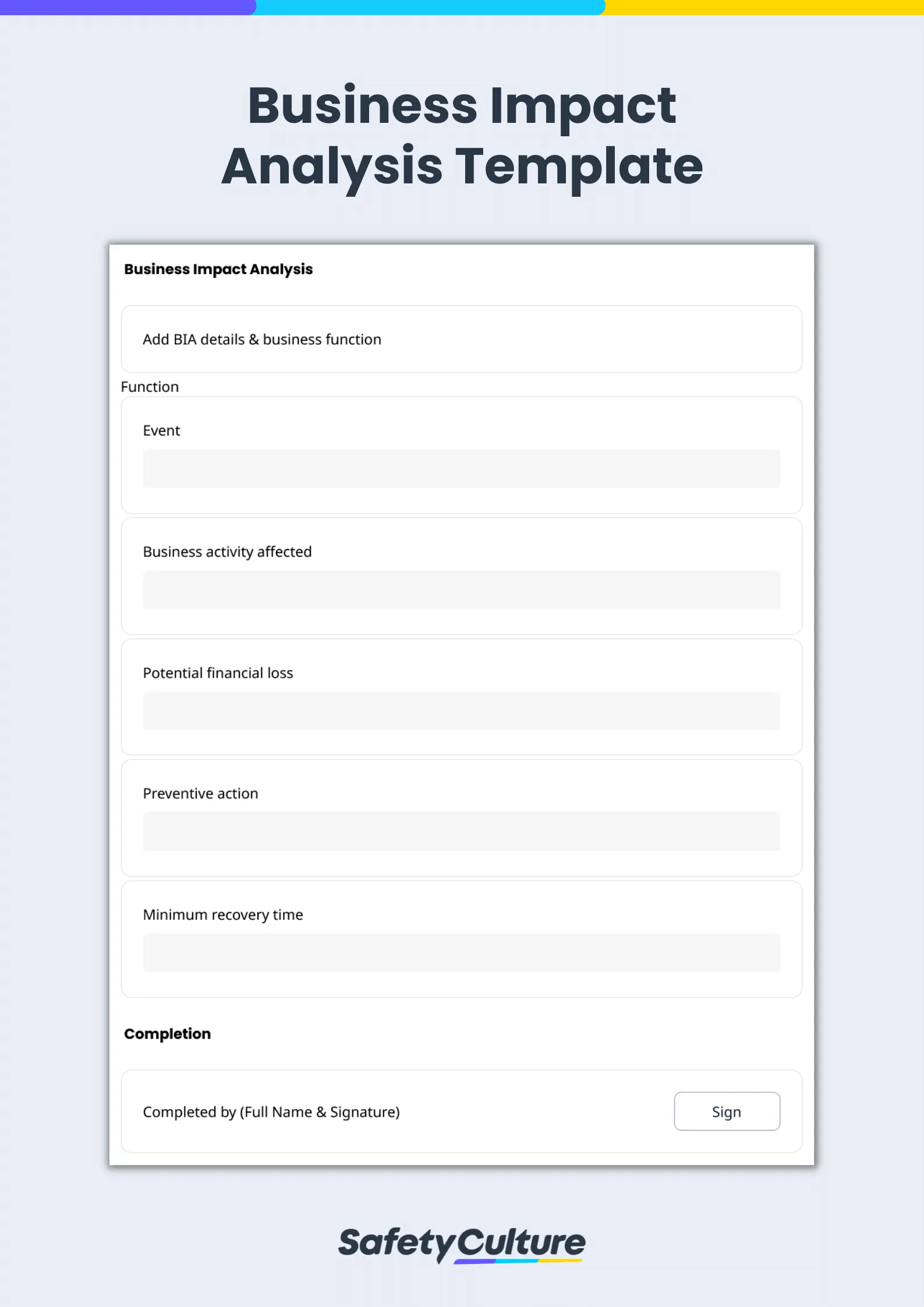What is Business Impact Analysis?
Business impact analysis is the process of planning for operational interruptions or disruptions caused by natural disasters or other similar incidents. It identifies and evaluates the impact of disasters and provides companies a basis for investment in recovery, prevention, and mitigation strategies. Conducting a business impact analysis aids companies in providing informed decisions, appropriate response, and proper resource allocation during a non-operation period.
What is a Business Impact Analysis Template?
A Business Impact Analysis (BIA) template is used to evaluate and document the potential negative impact on an organization in the event of an emergency disruption. It is used by management to measure the potential financial/ operational loss and minimum recovery times of critical functions during outages. It is an important first step to help management prioritize which areas to establish business continuity planning for.
3 Common Business Functions a BIA Template Should Focus on
Here are the most common business functions that are typically prioritized for an impact assessment:
- Building Access & Facilities Support
Building collapses, fires, or acts of terrorism can prevent physical access to workplaces. The impact of building disruptions can be severe and range from staff death, major operational disruption, and loss of revenue.
Identify the physical buildings that are most customer-impacting and interdependent with other operations. Assessed recovery times should be based on office relocations and/ or implementation of remote work environments. It is also important to perform a BIA on the expected alternate workplace location. A BIA can assist in identifying which physical buildings and divisions should be prioritized for continuity planning.
- Data Center Availability
Weather disasters, power outages, and server equipment failure can cause disruptions to data center operations. Loss of data center operations can impact external and internal communication channels and critical IT functions.
Engage senior IT departments to determine which servers (internal or cloud-hosted) support critical business functions. Assessed recovery times can depend on how long it would take to fix backup programs and/ or the amount of time needed to operate in an alternate data center.
- Loss of Key Positions
Loss of key executive roles in business operations can lead to loss of customer contracts, PR damage, and operational disruption. Loss of key roles can be due to sudden & unreported changes in key business processes, illnesses, or resignation.
Engage senior management and the Board to map out key positions, responsibilities, and departmental dependencies. The financial impact can be assessed against the probability of losing key customer contracts. The operational impact should also be assessed based on dependencies with other departments. Recovery time can be evaluated based on succession planning and remaining positions across the organization chart.
What are the Five Elements of a Business Impact Analysis?
Communication is key to administering a good business impact analysis. Any business should be able to gather all the necessary elements to ensure that recovery strategies are planned thoroughly. Here are the five elements that a business impact analysis should have:
- Management Support – getting support and approval from the stakeholders and higher management teams is the step that a business should do when performing a BIA. It helps link and coordinate important matters across the organization. This is where proper communication is needed the most to inform and educate all affected people on the reasons why a business impact analysis is important and in what specific areas it is needed.
- Critical Business Functions – identifying all critical business functions helps determine the people that will be heavily involved and affected in the process, and key processes and systems that will be impacted. Knowing how the organization is structured is essential to understanding how a business impact analysis will be done more effectively.
- Tools – business impact analysis tools serve as assistants to better documenting, reporting, analyzing, and gathering of vital information. These can be software or applications that can generate comprehensive reports, diagrams, charts, and other meaningful representations of the gathered information about possible impacts or effects of a disaster on a business.
- Procedures – after determining the business structure and the right tools, it is highly important to delegate the right tasks to the right people and at the right time. This means determining what to perform, who are the key persons to complete the tasks, how often should they perform the tasks, and what are some interruptions to expect in the operations. Always set specific dates for each task and function. Ensure that all steps and processes are recorded regularly.
- Conclusions – the last element that sums up all the findings during a business impact analysis. This is where recommendations, plans, and the next steps can be derived from. This is also where loopholes and other potential impacts should be determined and discussed. All findings should be further evaluated by the management team for approval of new business strategies.
How Do You Write a Business Impact Analysis?
Business impact analysis plays an important role in business decision-making. It helps prioritize the crucial areas of the business operations that can cause harm to the business in case of a non-operational period. It provides valuable analysis of the short and long-term effects of a disaster, pandemic, or incident. The following key aspects help create a business impact analysis.
- Gather business information
Gather information about business processes, finances, and employees. Plan, communicate, and interview leaders that work hands-on in the key areas to further identify the risks and analyze the business needs. - Identify the Recovery Time Objective
Recovery Time Objective (RTO) is the duration of time a service level must restore a business process after a disruption. It helps determine how long personnel can work during “downtime” without the support of applications they use. - Determine the Recovery Point Objective
Recovery Point Objective (RPO) is the acceptable data loss to users when an interruption to a business function occurs. This will help determine the estimated financial impact on the business. - State the manual continuity plan
Identify the manual workaround procedure of the business in the event of interruption or disaster. It helps prioritize business processes that cannot operate without the services. - Document and analyze data
Carefully analyze and decide business needs based on the gathered information. Document and discuss business impact analysis to the key individual including business partners, stakeholders, and investors.



